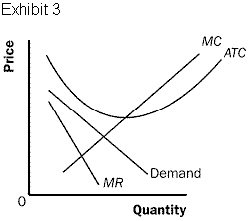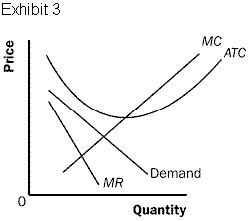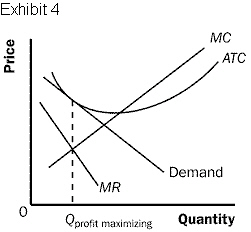True/False
Indicate whether the
sentence or statement is true or false.
|
|
|
1.
|
Monopolistic competition is a market structure in
which few firms sell similar products.
|
|
|
2.
|
Similar to firms in perfectly competitive markets,
firms in monopolistically competitive markets can enter and exit the market without restriction so
profits are driven to zero in the long run.
|
|
|
3.
|
In the long run, firms in monopolistically
competitive markets produce at the minimum of their average total cost curves.
|
|
|
4.
|
Similar to a monopolist, a monopolistically
competitive firm faces a downward-sloping demand curve for its product.
|
|
|
5.
|
Both monopolists and monopolistically competitive
firms produce the quantity at which marginal revenue equals marginal cost and then use the demand
curve facing the firm to determine the price consistent with that quantity.
|
|
|
6.
|
Since a monopolistically competitive firm charges a
price that exceeds marginal cost, the firm fails to produce some units that the buyers value in
excess of the cost of production and, thus, monopolistic competition is inefficient.
|
|
|
7.
|
In the long run, a monopolistically competitive
firm charges a price that exceeds average total cost.
|
|
|
8.
|
Economists generally agree that monopolistically
competitive firms should be regulated in order to increase economic efficiency.
|
|
|
9.
|
Firms that sell highly differentiated consumer
products are more likely to spend a large percentage of their revenue on advertising.
|
|
|
10.
|
Advertising must be socially wasteful because
advertising simply adds to the cost of producing a product.
|
|
|
11.
|
Critics of advertising argue that advertising
decreases competition while defenders of advertising argue that advertising increases competition and
reduces prices to consumers.
|
|
|
12.
|
Even advertising that appears to contain little
information about the product may be useful because it provides a signal about the quality of the
product.
|
|
|
13.
|
Brand names allow firms to make economic profits in
the long run because they are able to sell inferior products based on the apparent connection of
those products to the firm's unrelated high quality products.
|
|
|
14.
|
In a 1972 paper reporting his research on the
market for spectacles in the USA, economist Lee Benham found that spectacles were cheaper in states
that had prohibited advertising of spectacles.
|
|
|
15.
|
In the long run, a monopolistically competitive
firm produces at the efficient scale while a competitive firm has excess capacity.
|
Multiple Choice
Identify the
letter of the choice that best completes the statement or answers the question.
|
|
|
16.
|
Which of the following is not a characteristic of a
monopolistically competitive market?
a. | free entry and exit | b. | long-run economic profits | c. | many sellers | d. | differentiated
products |
|
|
|
17.
|
Which of the following products is least likely to
be sold in a monopolistically competitive market?
a. | breakfast cereal | b. | cotton | c. | video
games | d. | beer |
|
|
|
18.
|
Which of the following is true regarding the
similarities and differences in monopolistic competition and monopoly?
a. | The monopolist faces a downward-sloping demand curve
while the monopolistic competitor faces an elastic demand curve. | b. | The monopolist charges a price above marginal cost while the monopolistic
competitor charges a price equal to marginal cost. | c. | The monopolist makes economic profits in the long run while the monopolistic
competitor makes zero economic profits in the long run. | d. | Both the monopolist and the monopolistic competitor operate at the efficient
scale. |
|
|
|
19.
|
In the short run, if the price is above average
total cost in a monopolistically competitive market, the firm makes
a. | losses and firms exit the
market. | b. | profits and firms exit the
market. | c. | losses and firms enter the
market. | d. | profits and firms enter the
market. |
|
|
|
20.
|
 If the monopolistic competitor described by Exhibit 3 is producing at the
profit-maximizing (loss-minimizing) level of output, it If the monopolistic competitor described by Exhibit 3 is producing at the
profit-maximizing (loss-minimizing) level of output, ita. | is generating zero profits. | b. | is generating profits. | c. | could be
generating either profits or losses depending on what quantity it chooses to
produce. | d. | is generating
losses. |
|
|
|
21.
|
 The monopolistically competitive market shown in Exhibit 3 will, in the long
run, The monopolistically competitive market shown in Exhibit 3 will, in the long
run,a. | attract new producers into the market, which will shift
the demand faced by incumbent firms to the left. | b. | attract new producers into the market, which will shift the demand faced by
incumbent firms to the right. | c. | cause producers to
exit the market, which will shift the demand faced by incumbent firms to the
left. | d. | cause producers to exit the market, which will shift the
demand faced by incumbent firms to the right. |
|
|
|
22.
|
Which of the following is true regarding the
production and pricing decisions of monopolistically competitive firms? Monopolistically competitive
firms choose the quantity at which marginal cost equals
a. | marginal revenue and then use the demand curve to
determine the price consistent with this quantity. | b. | average total cost and then use the supply curve to determine the price
consistent with this quantity. | c. | marginal revenue
and then use the supply curve to determine the price consistent with this
quantity. | d. | average total cost and then use the demand curve to
determine the price consistent with this quantity. |
|
|
|
23.
|
 Exhibit 4 depicts a monopolistically competitor Exhibit 4 depicts a monopolistically competitora. | It is impossible to determine from this graph whether
the firm is generating profits or losses. | b. | generating profits
in the short run. | c. | generating zero
profits in the long run. | d. | generating losses
in the short run. |
|
|
|
24.
|
Which of the following is true with regard to
monopolistically competitive firms' scale of production and pricing decisions? Monopolistically
competitive firms produce
a. | at the efficient scale and charge a price equal to
marginal cost. | b. | at the efficient
scale and charge a price above marginal cost. | c. | with excess
capacity and charge a price above marginal cost. | d. | with excess capacity and charge a price equal to marginal
cost. |
|
|
|
25.
|
One source of inefficiency in monopolistic
competition is that
since price is above marginal cost, some units are not produced that buyers
value in
a. | since price is above marginal cost, surplus is
redistributed from buyers to sellers. | b. | monopolistically
competitive firms earn economic profits in the long run. | c. | monopolistically competitive firms produce beyond their efficient
scale. | d. | excess of the cost of production and this causes a
deadweight loss. |
|
|
|
26.
|
When firms enter a monopolistically competitive
market and the business-stealing externality is larger than the product-variety externality,
then
a. | there are too many firms in the market and market
efficiency could be increased if firms exited the market. | b. | the number of firms in the market is optimal and the market is
efficient. | c. | there are too few
firms in the market and market efficiency could be increased with additional
entry. | d. | the only way to improve efficiency in this market is for
the government to regulate it like a natural monopoly. |
|
|
|
27.
|
The use of the word "competition" in the
name of the market structure called "monopolistic competition" refers to the fact
that
a. | there are many sellers in a monopolistically competitive
market and there is free entry and exit in the market just like a competitive
market. | b. | monopolistically competitive firms face a
downward-sloping demand curve just like competitive firms. | c. | monopolistically competitive firms charge prices equal to the minimum of their
average total cost just like competitive firms. | d. | the products are
differentiated in a monopolistically competitive market just like in a competitive
market. |
|
|
|
28.
|
The use of the word "monopoly" in the
name of the market structure called "monopolistic competition" refers to the fact
that
a. | monopolistically competitive firms charge prices equal
to their marginal costs just like monopolists. | b. | a monopolistically
competitive firm faces a downward-sloping demand curve for its differentiated product and so does a
monopolist. | c. | monopolistically
competitive markets have free entry and exit just like a monopolistic
market. | d. | monopolistically competitive firms produce beyond their
efficient scale and so do monopolists. |
|
|
|
29.
|
Which of the following firms is most likely to
spend a large percentage of their revenue on advertising?
a. | the producer of a highly differentiated consumer
product | b. | the manufacturer of an undifferentiated
commodity | c. | a perfect competitor | d. | the manufacturer of an industrial product | e. | the producer of a low quality product that costs the same to produce as a
similar high quality product. |
|
|
|
30.
|
In the UK in 2002, the greatest amount of
advertising expenditures was for
a. | billboards. | b. | space in newspapers and magazines. | c. | commercials on television and radio. | d. | direct mail. |
|
|
|
31.
|
Which of the following is not put forth as a
criticism of advertising and brand names?
a. | Advertising manipulates people's tastes to create a
desire that otherwise would not exist. | b. | Advertising
increases competition, which causes unnecessary bankruptcies and layoffs. | c. | Advertising increases brand loyalty, causes demand to be more inelastic and,
thus, increases mark-up over marginal cost. | d. | Brand names cause
consumers to perceive differences between goods that do not exist. | e. | All of these answers are criticisms of advertising and brand
names. |
|
|
|
32.
|
Expensive television commercials that appear to
provide no specific information about the product being advertised
a. | may be useful because they provide a signal to the
consumer about the quality of the product. | b. | should be banned
by regulators because they add to the cost of the product without providing the consumer with any
useful information about the product. | c. | only affect the
buying habits of irrational consumers. | d. | are most likely
used by firms that are perfect competitors. |
|
|
|
33.
|
Which of the following is not an argument put forth
by economists in support of the use of advertising?
a. | Advertising increases
competition. | b. | Advertising
provides information to customers about prices, new products, and location of retail
outlets. | c. | Advertising provides a creative outlet for artists and
writers. | d. | Advertising provides new firms with the means to attract
customers from existing firms. |
|
|
|
34.
|
Defenders of the use of brand names argue that
brand names
a. | all of these answers | b. | are useful even in socialist economies such as the former Soviet
Union. | c. | provide information about the quality of the
product. | d. | give firms incentive to maintain high
quality. |
|
|
|
35.
|
Which of the following firms has the least
incentive to advertise?
a. | a manufacturer of breakfast
cereal | b. | a wholesaler of crude oil | c. | a restaurant | d. | a manufacturer of
home heating and air conditioning |
|